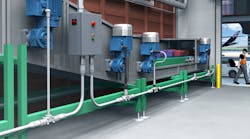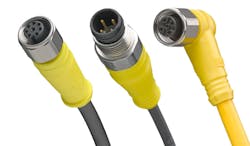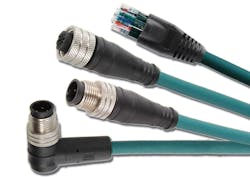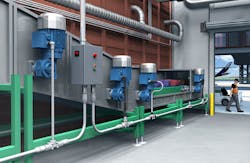Download this article in PDF format.
Traditional machine hardwiring involves a virtual maze of wires and cables. In modern machine setups, electrical, signal, and data contact points can number into the hundreds for complex operations or multifunctional machines.
For example, a machine designed to stamp, print, and cut paper combines extensive electrical, data, and signal schematics for three separate machines. Problems arise if each function does not know what the others are doing. So if printed paper is advanced before the cutting process completes the first batch, the machine jams, which can damage the product.
Typically, a host of sensors prevent problems and production delays. In hardwired machines, each point of power, sensor data, and control communications is transferred via cable or wire into a control panel or power panel. That can add up to hundreds of point-to-point contacts requiring stripping, soldering, and possibly crimping.
The Downside of Hardwiring
Before a hardwired machine even ships, all points of entry or input/output must be tested, which involves wiring each point, testing, and disconnecting. Then, every point-to-point contact is reconnected at the customer’s site by skilled technicians, electricians, or engineers. The process generates significant labor costs. Moreover, each wiring and unwiring process adds another layer of risk and exposure for machine builders. Even one misplaced wire can damage or destroy a machine worth hundreds of thousands of dollars.
To mitigate risks, machine builders often dispatch engineers to plants to oversee machine wiring during installation, or if a customer adds a new production line. Each site visit incrementally drives up the overall machine cost.
Customer technicians handling cumbersome wiring tasks depend on electrical and signal schematics to perform routine tasks and troubleshoot problems. A problem in a plant with several hardwired motors and drives may require disconnecting and reconnecting hundreds of point-to-point contacts to safely troubleshoot and diagnose the issue.
Machine-builder and end-user engineers working on industrial machinery in processing, manufacturing, and assembly plants are challenged by the time, cost, and complexity of commissioning and maintaining machinery. Typical automation configurations require many hours of labor to hardwire and power up systems for smooth operation and synchronization. And machines requiring routine maintenance must be disassembled, serviced, and reassembled. Once again, that means disconnecting and reconnecting each hardwired point, which, as mentioned, is a time-consuming task. Machine downtime always translates into productivity and profitability losses, and escalates total cost of ownership.
Going Modular
Onerous machine wiring tasks are common customer complaints. That’s why machine builders are manning the frontline in the transition from hardwiring to modular connectors. In new machines, as well as machines on the market for several years, improved connectivity often translates into greater customer satisfaction and loyalty, and a boost in sales.
Over 80% of the connectors used for machine applications are M12s, like those shown. They offer balance between size, performance, and easy handling. The connectors can handle up to 16 A of current.
Return on investment for modular connectors can come from:
- Reduced labor and commissioning time for machines, robotics, and assembly lines.
- Significant reduction in electrical commissioning time and total installed cost of machines.
- Highly reliable performance, IEC standardization, and NFPA-79 safety conformance.
- Faster, easier handling of maintenance and repair for higher productivity and less downtime.
- The flexibility and scalability to configure, modify, or expand machines and assembly lines as demands or operations change
Modular connectors provide excellent mechanical stability, eliminate labor-intensive wired installation in the field, and simplify routine testing and maintenance, especially when machines are in tight spaces or remote plant locations. Technicians can quickly disconnect devices using cordsets with custom configurations and colors, and plug directly into portable testing equipment. Such capability brings enormous labor savings in industrial plants with hundreds or thousands of connection points.
These benefits even spread to factory automation applications that demand increasingly complex and powerful machinery in compact sizes. Several modular connector sizes and styles have been specifically designed to address the tough requirements of harsh industrial machine applications and processes. Some of the more common ones include:
Heavy-duty connectors (HDCs): The primary role of industrial connectors is to maintain secure and reliable connections. But liquids, dust, and other contaminants can make their way into the connector housing during connection or disconnection or when in operation, which ultimately leads to outages and downtime. Certain harsh industrial environments, especially in the oil and gas, food and beverage, and automotive industries, are exceptionally punishing on electrical and electronic equipment.
HDCs are built to deliver years of uninterrupted performance in demanding applications. They may be built out of die-cast aluminum alloys with either a polyester powder finish (nickel-coated versions for EMC applications), or a self-extinguishing thermoplastic. Locking mechanisms consisting of mono-block levers in galvanized or stainless steel or, alternatively, springs and pegs in stainless steel, ensure secure seals, and coupling stability prevents them from accidentally opening due to vibrations or impacts. Internal protective gaskets seal out dust, water, and aggressive agents. The ruggedly constructed couplings provide long-term, reliable performance in the harshest industrial environments.
HDCs come in an array of configurations, shapes, and sizes. Cordsets with distinctly different connectors at each end make installing them logical and intuitive, dramatically reducing demands on engineering resources and eliminating wiring problems due to user error.
Modular HDC enclosures can be customized according to an end user’s specific requirements. Custom options include user-configurable rectangular connectors with different pin counts or voltages, and combinations that may include power, signal, coaxial, or other transmission media in a single connector. HDCs can combine RJ45s and signal pins, for example, for power, data, and signal in a single connector. Where several machines are involved, assembly remains consistent and repeatable, which reduces labor and delivers overall savings.
High-power M-Series connectors: Machines and assembly lines have stringent requirements for HDC and other standardized industrial connectors. Delivering exact industry specifications, M-series connectors ensure compatibility with other component suppliers, industrial-machine OEMs, and system layouts. Premolded cables for power distribution and motor control and patented push-to-lock M12 connectors streamline links to sensors, actuators, and other devices.
M40 connectors are commonly specified for high-power applications such as dynamic servo drives, packaging and material handling, automotive production lines, and other robotic operations, as well as any drive requiring compact high-power inputs. De facto industry standards include 6-pole (3+2+PE) and 8-pole (4+3+PE) connector configurations and standard length cordsets (2, 3, 5, 7, and 10 meters). Power pins rated up to 37 A with signal pins rated at 16 A deliver rapid connection times that minimize machine downtime and maintenance costs.
A range of M23 connectors and receptacles, which inherently meet stringent reliability and performance requirements, are also widely used for power applications (up to 28 A) in industrial automation and material handling. An M23 connector typically has six or eight wires for power and can go up to 19 signal wires. Field-attachable male and female cable connectors are available in straight and right-angled versions for design flexibility in front- or back-mounting machines. Integrated locking mechanisms allow for easy assembly and disassembly without the need for special assembly tools.
Double-ended cordsets offer engineers and designers a variety of different connectors to place on each end of the cordset.
In harsh and wet industrial environments, a properly sealed and IP67-rated M40 or M23 interface is recommended to prevent dust, water, and contaminants from getting inside the housing. Low-profile, pre-assembled, overmolded connectors and cordsets accommodate a broad range of cable outer diameters and receptacles. This helps mitigate wiring and assembly errors, and saves valuable time and space. Overmolding requires choosing the right materials and designing for tight connections in low and high temperatures. Quality connectors can create up to a 100% seal, while low-quality versions might be lucky to achieve a 70% seal.
Specialized oil- and weld-slag-resistant jacketed, shielded connector cables deliver exceptional bending and torsional performance over a wide range of operating temperatures. Pins enclosed in the contact carrier improve safety by preventing electrical shocks to hands and fingers due to exposed pins. Enhanced heat-dissipating designs handle heat more efficiently in compact, higher-current-carrying connectors.
The most at-risk components are connectors that hook into critical machine and control systems. They may require IP69K-rated direct-current or multipole connector inserts and enclosures that prevent moisture and contaminants from getting in, as well as resist vibration and temperature extremes.
Mainstay M12 connectors: About 80% or more of the connectors used in machine applications are a variant of M12. It offers the best balance between size, performance, and handling. Smaller M5 and M8 connectors are generally more fragile, so they tend to be used only in extremely space-constrained low-power and signal applications such as sensors.
The 16-A current capability of a standard M12 connector was developed to meet the most common power requirements of motors, solenoid-operated valves and actuators, and 24-V DC auxiliary power-distribution systems in machines and automation controls. It’s important to specify products designed in accordance with IEC Standard 61076-2-xxx, which established an open industry standard to increase adoption of standardized connectors for a wide array of platforms and manufacturers.
Smaller-footprint M12 power connectors provide multiple codings for electrical requirements in rugged designs for ease of use in factory automation equipment. For example (also, for list of the different codings, see "M12 Power Connector Sample Coding/IEC Standard" at the end of the article):
- M12 power F-Coding connectors deliver up to 300 V AC/DC and 16 A per pin. They also prevent mismating with other M12 connectors being used for input, output, signal, or industrial-network connections.
- M12 power L-Coding connectors accommodate 63 V AC/DC and 16 A current per pin, delivering four times the power of standard M12 connectors.
- M12 power T-Coding connectors deliver three times the power of standard M12 connectors with 63 V AC/DC and up to 12 A per pin.
Push-to-lock technology used in modular M12 connectors provide secure, long-lasting mating without turning a coupler. Technicians simply push down to connect and pull up to disconnect, thus saving a significant amount of time while eliminating repetitive hand/wrist motions needed to install traditional threaded M12 connectors. The results are higher productivity and shorter commissioning and time to production. The operational and business benefits grow over time, with up to an 80% reduction in electrical commissioning times for industrial machinery and automation systems.
Hybrid connectors: Hybrid connectors in a small build size are based on a circular M12 threaded-coupling design. Increasingly, M12 connectors are being used for conductive and optical sensors, and coded for Ethernet, PROFINET, and other active component bus connections to the programmable-logic-controller (PLC) backbone of industrial machinery and automation platforms.
A typical IP-sealed M12 circular hybrid connector might combine Cat5e Ethernet data speed and power lines with a 4-pin array (two shielded pairs) enclosed by a wraparound metal tube shield to minimize crosstalk and EMI for the best signal integrity and performance. An 8-pole circular hybrid connector (4+4) can include two Cat5e Ethernet data lines and four power lines and carry up to 6 A.
By putting power and data signal lines in one connector, hybrid connectors take up less space in machine designs and reduce cabling requirements, installation time, and associated costs, especially in harsh industrial applications. Sealed hybrid connectors are ideal for industrial process and automation control equipment, or any application requiring power and data in one device. The shielding concept is not limited to an M12 build size, and can be developed for other form factors, such as M16 or M23.
Advantages of Modular Connectors
Traditional hardwiring has been standard for industrial automation and machine power, signal, and data. However, industrial machine builders now lean more toward modular connectors as more industrial applications and customers demand versatility, flexibility, and greater reliability.
In this application, a high-power line feeds cables that take it up to individual blue-colored drives.
To sum up, designers and installers of machinery for use in manufacturing and assembly plants have long been challenged by the time, cost, and complexity of commissioning machinery once it is on-site. Robotic and other complex automated machinery can require many hours of labor by licensed professionals to configure, power, and synchronize for precise operating parameters. These steps lead to delays in deployment and rapid escalation in the total cost of ownership. When hardwired systems require routine maintenance, they must be disassembled, serviced, and reassembled—racking up more time and cost. Productivity and profitability fall as time and labor costs mount.
Although they offer a lower-cost upfront investment, hardwired connections are at higher risk of mechanical failure due to corrosion—or human error. Finding ways to streamline and simplify machine maintenance is an ongoing challenge for designers, builders, plant engineers and managers.
In harsh industrial environments, modular connectors more reliably withstand heavy use and exposure. Quick-disconnect power and signal connectors and cordsets are factory molded and constructed of crush-resistant material to easily replace machine hardwiring.
Modular power and signal connectors ship only after pretesting, a significant advantage over a hot-wired installations that rely primarily on an installer’s qualifications and expertise. To disassemble and reassemble a machine for maintenance or plant reconfiguration, technicians need only disconnect and reconnect the cordsets and connectors for machines, sensors, actuators, and other equipment. This means a complete, compliant connectivity network installs quickly and easily by trained technicians rather than licensed professionals, without the time and effort needed for cable pulling and hardwiring installation and terminations.
Power and signal requirements demand connectors that withstand chemical wash-downs and extreme temperatures, humidity, and dirt. Reliable IP-rated HDC and M-series connectors deliver industry-standard solutions with multiple coded variants for industrial connectivity applications. They can also be simpler to configure, modify, or expand as machines or operations change or to accommodate plant-floor redesigns.
M12 Power Connector Sample Coding/IEC Standard
- A-code: IEC 61076-2-101 - 0.34 mm2 / 22AWG - up to 4 A – 60 V AC/DC
- T-code: IEC 61076-2-111 - 1.5 mm2 / 16AWG - up to 12 A – 63 V AC/DC
- S-code: IEC 61076-2-111 - 1.5 mm2 / 16AWG - up to 12 A – 630 V AC/DC
- L-code: IEC 61076-2-111 - 2.5 mm2 / 14AWG - up to 16 A – 63 V AC/DC
- F-code: IEC 61076-2-111 - 2.5 mm2 / 14AWG - up to 16 A – 300 V AC/DC




